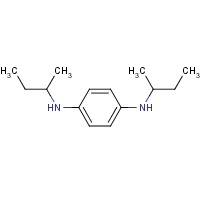N,N'-Di-sec-butyl-p-phenylenediamine
Agent Name
N,N'-Di-sec-butyl-p-phenylenediamine
CAS Number
101-96-2
Formula
C14-H24-N2
Major Category
Nitrogen Compounds

Synonyms
1,4-Benzenediamine, N,N'-bis(1-methylpropyl)-; Antioxidant 22; Du Pont Gasoline Antioxidant No. 22; Kerobit BPD; N,N'-Di-s-butyl-p-phenylenediamine; N,N'-Di-sec-butyl-p-phenyldiamine; N,N'-Di-sec-butylparaphenylenediamine; N,N'-Di-sek.butyl-p-fenylendiamin [Czech]; Santoflex 44; Tenamene 2; Topanol M; UOP 5; p-Phenylenediamine, N,N'-di-sec-butyl-; [ChemIDplus] UN2922
Category
Amines, Aromatic
Description
Pale yellow or amber to red liquid; mp = 18 deg C; [HSDB] Dark red liquid; [MSDSonline]
Sources/Uses
Used in gasoline (gum inhibitor, antioxidant, and stabilizer) and styrene-butadiene rubbers (antioxidant and antiozonant); [HSDB]
Comments
Emergency treatment: "Paraphenylenediamine"; In sensitized individuals, paraphenylenediamine may cause allergic contact dermatitis following application as a hair dye and asthma following inhalation; Following ingestion, can cause angioneurotic edema, methemoglobinemia, acute tubular necrosis, and hepatotoxicity; An adult died after ingestion of 3 grams of p-phenylenediamine; Another adult who ingested 1800 mg developed angioneurotic edema and acute renal failure; [HSDB] A strong irritant that may cause burns; [CAMEO] Highly irritating or corrosive to skin and eyes, based on animal studies; [eChemPortal: HPVIS] Causes burns; May cause skin sensitization; Toxic if swallowed; Absorbed through skin; [Aldrich MSDS] See "p-Phenylenediamine."
Biomedical References
Exposure Assessment
Vapor Pressure
0.00156 mm Hg
Lethal Concentration
LCLo (rat) = 600 mg/m3/6h
Explanatory Notes
The Guide in the Emergency Response Guidebook is for "Corrosive liquid, toxic, n.o.s." VP from ChemIDplus;
NFPA
high ambient temp required
Adverse Effects
Skin Sensitizer
Yes
Methemoglobinemia
MetHgb is secondary toxic effect
Hepatotoxin
Hepatoxic (a) from occupational exposure (secondary effect) or (b) in animal studies or in humans after ingestion
Dermatotoxin
Skin burns
Diseases, Processes, and Activities Linked to This Agent
Diseases
Occupational diseases associated with exposure to this agent:
Processes
Industrial Processes with risk of exposure: